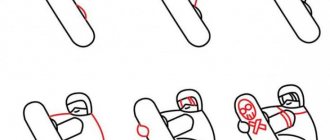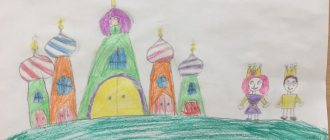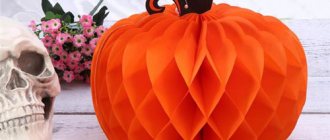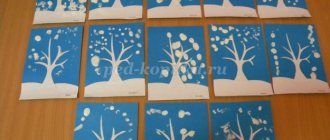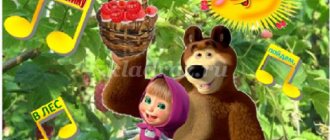Summary of an integrated lesson in the preparatory group on the topic: Winter
Summary of an integrated lesson for children 6-7 years old: “Zimushka - winter”
Hello, winter - winter, you brought the birds to visit us
Author: Efimova Alla Ivanovna, teacher of GBDOU No. 43, Kolpino St. Petersburg
Description: This summary will be of interest to preschool teachers, additional education teachers and parents. Designed for children of older preschool age. Goal: expanding and systematizing children’s knowledge about winter. Tasks: - expand and activate the vocabulary on the topic “Winter”; - develop the ability to maintain a conversation, select words and adjectives; develop attention, observation, fine motor skills; — to cultivate love and respect for nature, a sense of kindness, empathy for everything living and beautiful, to cultivate the ability to work in pairs; - development of emotional perception in children, create a joyful mood in children, create a desire to participate in games, enjoy winter, winter games; - practice writing sentences and stories based on the picture. Preliminary work: conversation about the signs of winter; viewing winter landscapes, pictures of animals and birds; guessing riddles, reading poems, stories and fairy tales on a winter theme; making bird feeders. Preparation for the lesson: sheets of white cardboard with printed bird patterns, glue, cereals (millet, rice, buckwheat), brushes, napkins.
Educator: Guys, you probably noticed that something has changed in our locker room? Have you noticed these changes, tell me about them? Children's answers: A lot of beautiful paintings appeared, and each child has a small but very beautiful picture on his locker. Educator: Correct. How do you think these paintings are interconnected? Answers: All the pictures show winter.
Educator: Correct. But it’s not for nothing that I decorated your cabinets with such beautiful pictures. Over the course of a week, you carefully examine your picture, study it, and then describe it to me in detail (or rather, tell me what you saw in it). On the weekend, you can ask your parents to help you write a short story about your painting, or write it yourself (after all, most children already write themselves), supplement it with your own drawing. This will be your homework. Our group is also decorated with paintings on the theme - winter. I invite you to describe this wonderful time. Children's answers. Educator: You are all great fellows, you said so many wonderful words about this wonderful time, I want to invite you to guess the riddles. - There are four brothers, each of them has three months. What kind of brothers are these? (seasons) - Covers everything with a snow-white blanket. What time of year? (winter) - This month welcomes winter, the New Year holiday invites us. (December) - He is the owner of the forest, He loves honey, and sleeps in winter. (bear) - He is always very nimble, He has a beard. He crawls into our felt boots, and our noses freeze. He even pinches our cheeks, Who is this... (frost) - Falls beautifully from the sky, And dances on the fly. It sits in the palm of our hand, and immediately turns into water. (snow) - A small animal, Loves carrots, jumps deftly. Changes color, and his name is...(bunny) - The people rejoice, When...(winter) comes to us. — The granddaughter who always goes with Grandfather? (Snow Maiden) Educator: Do you know winter fun? Which?
Children's answers. Educator: I invite you to the rug, I’m starting some winter fun. “Winter Games” The children began to ride (hold your palms horizontally in front of your chest and make movements back and forth, as if skiing), and tumble in the snow (make synchronized circular movements with your hands in front of your chest: with your right hand clockwise, and with your left hand counterclock-wise). They wanted to play snowballs (move the “snowball” from one palm to the other) They began to sculpt them and throw them at each other (“make” a snowball, and then pretend to “throw” it at someone). They began to roll snowballs (imitate the corresponding movements) - sculpt a snow woman (from the bottom up with both hands, simultaneously draw three snowballs standing on top of each other: large, medium and small) Fun in the winter! I don't want to go home! Educator: We rested a little. Guys, tell me what winter is like? Answers: snowy, cold, cheerful, blizzard, blizzard, frosty, snow-white, harsh, silver, beautiful, beloved, etc. Educator: That's right, and now the game is the other way around. You described winter in such beautiful long words, but now it’s the other way around. The word winter is long, and short is winter. Snezhnaya... – snow; Vyzhnaya... - Vga; Blizzard... - blizzard; Frosty... - frost; etc. Educator: Now I’ll start the sentences, and you finish. — In winter, the branches of the trees... are covered with snow. - Houses, forests, paths... are covered in snow. — The bear in winter...hibernates. — Children love...to play in the snow. — Rivers in winter... become covered with ice. — We hide our hands from the cold in mittens. — White snowflakes are swirling in the air. - The bunny changes... the color of his fur coat. — In winter, the nights are long, ... the days are short. — We dress warmly... so as not to freeze. — Birds fly away... to warmer climes. Educator: guys, let's remember our little friends. Remember the birds that fly to warm countries, why they fly there and tell me about the birds that live with us in winter. What do they eat, how do they live?
Children's answers. Educator: Well done. Listen to a poem about birds. New Year's carnival. Do you know that miracles happen in winter? That in the forest on New Year's Eve, all the birds are collected? Good Grandfather Frost gives out gifts. Some people ask for a handful of grains, others for bright feathers. Having listened to the requests, Frost reasons wisely: “You need to survive the winter, find food in the morning.” And he carefully gives the little beggars a very modest outfit, there are no scarlet feathers in it. Santa Claus tries to decorate only those who live far from villages and eat in the forest. And the Woodpeckers, Hazel Grouse, and Crossbills are happy and cheerful. How good they are, in the feathers of their dreams! And the most beautiful and wonderful of all, little King. With the proud air of an autocrat, he sits down on a tree stump. The fun begins, the New Year's carnival. So much joy and laughter! It's a pity you weren't there. (Batuy Irina) Educator: A beautiful poem, isn’t it? Let us be Santa Clauses for our little friends today and give them small gifts with our own hands. These will be feeders for friends. But first, I suggest you prepare our hands and fingers. Finger gymnastics: We are friends in our group - girls and boys connect their fingers. - to the castle (several times) You and I will make friends Little fingers. One, two, three, four, five - fingers from the little finger alternately. We begin to count. - connect with each other One, two, three, four, five We’ve finished counting (Hands down, shake hands) Sit down at your workstations, in front of you are leaves with pictures of birds, I suggest you paste over our birds with different cereals. After completing our work, we will take our gifts - feeders outside and treat the birds. I turn on calm music, the children begin to do their work, and whoever needs help, I help. Educator: Our time is coming to an end, we are slowly finishing our work, cleaning up our workplaces... What wonderful feeders they turned out to be, I’m sure the birds will be very happy. Well done everyone. And now I suggest going for a walk and taking our feeders with you.
Educator: They guessed the riddles, they told me the stories. The feeders were made. And probably a little tired. To relieve your fatigue, I suggest you play. Come out here, everyone, create a gate. Through these gates, it's time for us to go to the locker room. Dress warmly, get ready for a walk.
We recommend watching:
Summary of educational activities for speech development in the preparatory group. Reading Nosov’s story “On the Hill” Notes of a lesson on application in the preparatory group on the topic: Winter in the city Notes of GCD on physical education in the preparatory group with a presentation. Skiing Synopsis of OOD for children of the preparatory group on the topic: Winter
Similar articles:
Walks in the preparatory group. Card file with goals for December
Walks in the preparatory group. Card file with goals for January
Walks in the preparatory group. Card file with goals for February
Educational lesson on the topic “Winter” in the preparatory group
Summary of a lesson on speech development in the preparatory group on the topic: “Winter, winter!”
Municipal autonomous preschool educational institution
"Child Development Center - Kindergarten No. 2"
g.o. Saransk
Summary of a lesson on speech development in the preparatory group on the topic: “Winter, winter!”
Prepared by teacher: Medvedeva A.A.
Saransk 2022
Target:
teach children to compose stories based on a picture plan and questions; maintain interest in intellectual activity.
Software tasks:
Educational:
form the concept of “seasons”, clarify knowledge about the signs of winter, learn to write short stories.
Educational:
develop speech breathing, general and fine motor skills, attention, thinking, memory. Develop oral coherent monologue speech skills.
Educational:
develop the ability to listen to a friend’s answer, develop the skill of self-control and self-esteem
Methodical techniques:
gaming, visual, verbal, practical.
Preliminary work:
reading stories and memorizing poems about winter, looking at reproductions of paintings about winter, talking about the seasons.
Equipment:
story pictures about winter, picture outline of the story, magnetic board, fake snowball, cut-out pictures with signs of winter according to the number of children, multimedia projector, presentation “Winter”.
Organizing time:
Playback:
Hello guys, today we will talk about one time of year, and guess which one - guess for yourself: Snow falls,
The blizzards are howling
Celebrate the New Year
When does this happen?
Children:
This happens in winter.
Playback:
That's right, this happens in winter. And I suggest you play a game called “Winter”
Game "Winter"
I will say the beginning of the sentence, while throwing you a snowball, and you will add the word “winter”, but at the same time correctly change the ending, returning the snowball to me. Well, here it comes..... (winter) A lot of snow fell this....(winter)
We have been waiting for this…..(winter) for a very long time. All the children are happy about the arrival of….(winter) We told our grandmother about our….(winter) We had fun playing….(winter)
GCD move:
Playback:
Okay, guys, what winter months do you know?
Children:
We know December, January and February.
Playback:
Name the first month.
Children:
The first winter month is December.
Playback:
What holiday is in December?
Children:
New Year!
Playback:
That's right, now name the second month of winter.
Children:
The second month of winter is January.
Playback:
What holiday do we celebrate in January?
Children:
In January we celebrate Christmas.
Playback:
Okay, well, who will name the last, third month of winter?
Children:
The third month of winter is February.
Winter fun. Lesson in a preparatory group on speech development
Summary of GCD in the preparatory group of the kindergarten “Winter Fun”
Topic: “Winter Fun” Purpose: to clarify children’s knowledge about winter and winter fun; Objectives: Educational
: activate vocabulary on the topic “Winter, winter fun”;
Developmental:
develop observation, activity, attention;
Educational:
to instill in children feelings of love and respect for nature.
Preliminary work: Observing the weather, signs of winter; conversations, looking at illustrations about winter, reading stories and poems about winter, winter games. Equipment: Snowman toy, snowballs, story pictures, chips.
Progress of GCD
1. Organizational moment.
All children stand in a circle.
Educator: -Children, guess the riddle: “Roll through the snow - I’ll grow up, warm you up on the fire - I’ll disappear.” What is this? Children: - Snowball! Educator: - A snowball of kind greetings rolled into our group. I suggest smiling at each other, and, passing the “snowball” one by one, say hello to the neighbor standing on the right, saying a kind word to him. He passes the “snowball” on. Children complete the task and go to their seats. Educator: The beauty of winter has arrived. Brought us a lot of snow. And with it came frost. It stings your ears, stings your nose. Not an evil frost. He brought a lot of joy! He brought winter fun. Everything that gives children joy! What time of year is the poem talking about? (children's answers)
.
What is there no winter without? Children: - No snow, no frost, no blizzard, no blizzard, no ice, etc. Educator: To find out what we will talk about in class, you must solve the puzzle. Exercises "Rebus". — Improving the skills of sound-letter analysis of words, developing visual analysis. Educator: - Look at the board and determine the word by the first sounds - the names of the pictures. Pictures : Olympic hare, orange, rolling bagel, orange, mittens, Aibolit. (Children define the word “Fun”)
.
Educator: - You did an excellent job. Today we will talk about winter fun and winter sports. And why you need to spend more time in the fresh air. Educator: There are a lot of winter activities. Let me now tell you different winter activities, if I say it correctly, then clap your hands: In winter they go skiing. In winter they swim in the river. In winter they go ice skating. In winter they ride a bicycle. In winter they go sledding. In winter they go barefoot. In winter they play snowballs. Educator: Winter is a beautiful, wonderful time. Miracles happen in winter! A miracle will happen to you and me today. A snowman will come to visit us. A snowman comes in and cries. Educator: Hello, snowman, why are you crying? Snowman: Hello children, there are a lot of you here, but I’m standing completely alone on the street and I’m sad, I have no one to play with. Educator: Don't be upset, snowman, play with us. — Children, tell us what interesting things you can do outside in winter? Children's answers about what you can do in winter: build a snowman, throw snowballs, sled, ski and skate, play hockey, build forts out of snow. Physical education lesson We play snowballs in winter, (Stand in a circle. “Make snowballs.”)
We walk through the snowdrifts,
(They walk one after another in a circle.)
And we run on skis,
(Imitation of skiing.)
We fly on ice skates .
(Imitation of ice skating.)
Together we build a fortress,
(They hold hands and walk in a circle.)
We love winter as a guest!
(They disperse, making a large circle.) Educator: In winter, the whole earth is covered with snow, let's play with the word “snow”, Game “Say a word” Quietly, quietly, as in a dream, Falls to the ground (Snow)
Fuzzes all slide from the sky - Silvery
( Snowflakes)
To the villages, to the meadow Everything is falling
(Snowball)
Everyone is running in a race, Everyone wants to play
(Snowballs)
Like in a white down jacket Dressed up
(Snowman)
Nearby there is a snow figure - This girl -
(Snowmaiden)
Like in a fairy tale, like in a dream, the Earth decorated everything
(Snow)
Repeat all related words to the word SNOW.
(children's answers: snow, snowflakes, snowball, snowballs, snowman, snow maiden, bullfinches)
.
Snowman: Children, I completely forgot, I brought you a bucket of snow. Educator: Great, now we’ll play with the snowball. Take one snowball at a time and stand in a circle. Repeat the movements after me. I roll the snowball in circles, (between palms)
I push it back and forth,
(change of hands)
I stroke my palm with it,
(respectively)
As if I were sweeping away crumbs,
(change of hand)
And I squeeze it a little,
(respectively)
Like a cat squeezes its paw.
(change of hands)
I’ll press the ball with each finger
(respectively)
And with the other hand I’ll start,
(change of hands)
And now the last trick: The snowball flies between the hands.
(throwing a snowball from hand to hand)
Snowman: Well, now you can throw snowballs
(playing snowballs)
.
You must name any type of winter sports equipment, any winter fun and hit the target (basket)
in front of you with your snowball.
Exercise “Form a word” Improving the grammatical structure of speech: developing word formation skills. - I start a sentence, you finish it by forming a phrase that answers the question “Who?” — Ice skating — …………. Skater. — Sledding — …………… Sleighman. - Skiing - ……………. Skier. — Plays hockey — ………………. Hockey player. — Engaged in figure skating — ………….. Figure skater. Educator: Well done, children! We completed all the tasks. The snowman really enjoyed playing with you. Did you like it? Snowman: Oh, it’s very warm here and I think I’m starting to melt. It's time for me to leave. Goodbye. 3. Summary of the lesson
Each child is given a red and green chip.
Educator: - We will play the game “What is good, what is bad.” If you hear that this is a wrong action, you must raise a red chip, and if it is correct, then a green chip. 1. Do you sit for a long time at the computer when the weather is sunny and frosty outside? 2. Watch cartoons all day while your friends sled down the hill? 3. Going to the skating rink with your girlfriend? 4. Help your friends build a snow fort? 5. Play the computer game “Hockey” for an hour? 6. Should the whole family go on a ski trip? Educator: - And I would like to end our lesson with a proverb familiar to everyone. I’ll start, you will continue it: “Who goes in for sports - .....”. Children: -......doesn’t know anything about diseases!”
We recommend watching:
Summary of a lesson on application for children in the preparatory group. Quilling “Snowflakes” Summary of GCD in mathematics using ICT in the preparatory group “Winter” Summary of a lesson in kindergarten on the topic: Winter for children of the preparatory group with ONR GCD on a winter theme for children of the preparatory group
Similar articles:
Summary of a winter walk in the preparatory group “Observing coniferous trees”
Summary of a winter walk in the preparatory group “Observing public transport”
Summary of a winter walk in the preparatory group “Wind Observation”
Summary of a winter walk in the preparatory group “Observing the Bullfinch”
Summary of a walk in the preparatory group “Observing a Blizzard”
